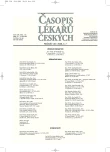Changes of hsCRP Levels Induced by Different Application Ways of Estrogene Replacement Therapy
Vliv různých aplikačních forem estrogenní substituční terapie na hladiny C-reaktivního proteinu
Východisko.
Jedním z nezávislých rizikových faktorů kardiovaskulárních nemocí je C-reaktivní protein. Cílem studie bylo zjistit jeho změny při různých aplikačních formách estrogenní substituční terapie.
Metody a výsledky.
V prospektivní randomizované 12týdenní intervenční studii byl v cross-over designu podáván estradiol perorálně v dávce 2 mg denně nebo transdermálně v dávce 50 μg denně. Zařazeno bylo 41 zdravých postmenopauzálních žen do 12 týdnů od chirurgické kastrace s průměrným věkem 49±6 let. Průměrná bazální hodnota hsCRP byla 3,3 mg/l. Po perorální léčbě došlo k signifikantnímu (p=0,05) nárůstu hladiny na 4,8 mg/l. Transdermální léčba nevyvolala významné změny (p=0,87). Rozdíl mezi vlivem perorální a transdermální estrogenní substituční terapie na hladinu hsCRP je statisticky významný s p=0,002.
Závěry.
Transdermální estrogenní terapie je z pohledu hsCRP šetrnější k cévní stěně. Rozdíl proti perorální léčbě je patrný i při časném zahájení hormonální substituce.
Klíčová slova:
hormonální substituční terapie, hsCRP, kardiovaskulární nemoci.
Authors:
Tomáš Fait
; M. Vráblík 1; M. Koštířová 2; B. Trnková 2
Authors‘ workplace:
Gynekologicko-porodnická klinika 1. LF UK a VFN, Praha
; III. interní klinika 1. LF UK a VFN, Praha
1; Ústav klinické biochemie l. LF UK a VFN, Praha
2
Published in:
Čas. Lék. čes. 2006; 145: 571-574
Category:
Original Article
Overview
Background.
C-reactive protein is one of the independent risk factors of cardiovascular diseases. The aim of study was to find changes of hsCRP levels during transdermal and oral application of estrogen replacement therapy.
Methods and Results. Two application ways were used for 12 weeks:
oral estradiol 2 mg/day and transdermal estradiol 50 μg /day (7-day patches). 41 healthy women with average age 49±6 years were randomised into prospective cross-over designed study. The average level of hsCRP before therapy was 3,3 mg/l. Elevation on 4,8 mg/l after the oral therapy was significant (p=0,05). Transdermal estrogene therapy did not induce any significant (p=0,87) changes. Differences between oral and transdermal therapy were significant (p=0,002).
Conclusions.
The transdermal application of the estrogene replacement therapy is more safety for a vessel wall from the view of hsCRP levels. Differences between transdermal and oral application way are apparent even in case of the early start of hormone replacement therapy.
Key words:
hormone replacement therapy, high sensitive C-reactive protein, cardiovascular diseases.
Labels
Addictology Allergology and clinical immunology Angiology Audiology Clinical biochemistry Dermatology & STDs Paediatric gastroenterology Paediatric surgery Paediatric cardiology Paediatric neurology Paediatric ENT Paediatric psychiatry Paediatric rheumatology Diabetology Pharmacy Vascular surgery Pain management Dental HygienistArticle was published in
Journal of Czech Physicians

- Metamizole vs. Tramadol in Postoperative Analgesia
- Metamizole at a Glance and in Practice – Effective Non-Opioid Analgesic for All Ages
- Advances in the Treatment of Myasthenia Gravis on the Horizon
- What Effect Can Be Expected from Limosilactobacillus reuteri in Mucositis and Peri-Implantitis?
- The Importance of Hydration in Wound Healing
Most read in this issue
- Autosomal Recessive Ethnical Diseases of Czech Roma
- Paediatric and Adolescence Gynaecology in Czech Republic
- Hippocampus, Structure of the Brain and Schizophrenia
- Trends in the Clinical Biochemistry and Laboratory Diagnostics
